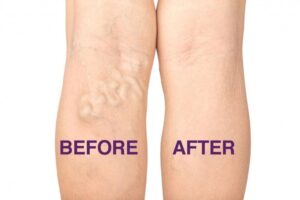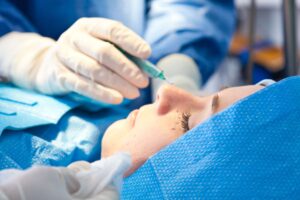Key Takeaways
-
Sclerotherapy is a proven treatment for spider veins, offering a minimally invasive option that can significantly improve the appearance of affected areas.
-
Preparation is key; following pre-treatment guidelines such as avoiding certain medications and applying no lotions or creams to the treatment area can enhance the effectiveness of sclerotherapy.
-
Understanding the procedure can help alleviate any anxiety. It involves injecting a solution directly into the veins, causing them to shrink and eventually disappear.
-
Post-treatment care is crucial for optimal recovery. Wearing compression stockings and avoiding sun exposure can help in achieving the best results.
-
Managing side effects properly, like mild discomfort or bruising, ensures a smoother recovery process. Most side effects are temporary and should not cause alarm.
-
The expected outcomes of sclerotherapy can include improved appearance and relief from discomfort, but patience is necessary as results vary and may take several weeks to become apparent.
Preparing for Treatment
Pre-Procedure Guidelines
Before undergoing sclerotherapy for spider veins, consulting a dermatologic surgeon is crucial. They assess if this treatment suits your needs. It’s essential to discuss your medical history and any medications you’re taking. Some medicines or supplements might affect the procedure’s success. For instance, blood thinners could increase bleeding risks.
On the day of the procedure, prepare your skin properly. This means not applying any lotions or oils. Clean skin ensures better results and reduces the chance of complications.
Lifestyle Adjustments Before Treatment
Hydration plays a key role in preparing for sclerotherapy. Increase water intake days before the treatment to ensure your body is well-hydrated. This can help with recovery and improve the overall outcome.
Consider your clothing choices too. Start wearing loose-fitting clothes to make it easier during and after the procedure. Tight clothing might cause discomfort or interfere with healing.
Lastly, limit sun exposure before getting treated. Sunbathing can darken the skin, making it more challenging to treat spider veins effectively. It may also lead to post-treatment complications like discoloration.
Understanding the Procedure
Steps of Sclerotherapy
The process begins with cleaning the area around the spider vein. This ensures a sterile environment for treatment.
A healthcare professional then uses a fine needle to inject a special solution into the vein. This solution irritates the lining of the blood vessel, causing it to collapse and stick together.
After injection, compression and massage are applied. They help spread the solution evenly within the vein, enhancing its effectiveness.
What to Expect During Treatment
Patients often feel a mild discomfort or stinging sensation during the injection. However, this discomfort is usually brief.
The entire sclerotherapy session typically takes between 15 to 30 minutes. The duration depends on how many veins are being treated in one session.
One of the key benefits of sclerotherapy is that patients can walk and resume normal activities almost immediately after. Moving around helps improve blood flow through other veins.
Recovery and Care
Immediate Post-Treatment Advice
After undergoing sclerotherapy for spider veins, immediate aftercare is crucial. Patients should wear compression stockings as their doctor recommends. These stockings aid in healing by maintaining pressure on the treated veins.
Avoiding strenuous activities is also vital. Your physician will specify how long to rest before resuming heavy exercise or lifting. This period allows your body to heal without unnecessary strain.
Keep the treated area clean to prevent infection. For the first few days post-treatment, avoid applying direct heat, like heating pads, or taking hot baths. Such heat can cause swelling and discomfort, slowing down the recovery process.
Long-Term Recovery Tips
For long-term care, continuing to wear compression stockings is essential. Follow your doctor’s advice on how long to keep wearing them. They not only support the initial recovery but also help in maintaining the treatment results.
Incorporate regular walking or light exercise into your routine. This activity promotes good circulation, which is key to preventing future spider veins from forming.
Protecting your skin from sun exposure is critical too. Sun can lead to skin discoloration around the treated areas. Use sunscreen or cover up when outdoors to minimize this risk.

Managing Side Effects
Common Side Effects
After undergoing sclerotherapy for spider veins, patients might notice temporary swelling, bruising, or redness at the injection site. These are common reactions that usually resolve on their own within a few days to weeks.
In some cases, individuals may see small ulcers or dark spots appear. This happens due to iron from the blood accumulating under the skin. Mild discomfort or muscle cramps in the treated area can also occur but typically diminish with time.
When to Seek Help
It’s crucial to monitor your healing process after sclerotherapy. If you experience severe pain, swelling, or signs of infection like warmth and redness at the injection site, seek medical attention immediately. These symptoms could indicate complications requiring prompt treatment.
The appearance of large ulcers or significant changes in skin color around the treated area is another red flag. If you show signs of an allergic reaction to the sclerosing solution used in treatment—such as hives, difficulty breathing, or swelling of the face and limbs—contact your healthcare provider without delay.
Expected Outcomes
Short-Term Results
Patients often notice a visible reduction in spider veins within three to six weeks after undergoing sclerotherapy. This quick response is a significant advantage of the treatment. However, it’s common to experience temporary side effects such as bruising and swelling. These usually diminish after a few days, providing relief and visible improvement.
For those with more severe cases, achieving optimal results may require multiple sessions. The number of treatments depends on the severity and extent of the veins.
Long-Term Benefits
Over time, treated veins undergo permanent closure and gradually fade away. This leads to an improved skin appearance and boosts confidence for many patients. They no longer feel the need to hide their legs due to unsightly spider veins.
Moreover, sclerotherapy offers health benefits beyond cosmetic improvements. It can decrease the risk of leg swelling, aching, or cramping that is often associated with varicose veins. This improvement in symptoms contributes to a better quality of life.
Final Remarks
Sclerotherapy stands out as a game-changer for those of you battling spider veins, offering a blend of effectiveness and minimal downtime. By now, you’re armed with knowledge on preparing, what the procedure entails, aftercare essentials, managing side effects, and what results to expect. This comprehensive guide aims to equip you with confidence in your journey towards clearer skin. Remember, the success of sclerotherapy hinges not just on the procedure itself but also on how well you follow through with post-treatment care and manage expectations.
Don’t let spider veins hold you back any longer. Take action today by consulting a qualified professional who can tailor a treatment plan suited to your needs. Your path to vein-free legs is clearer than ever. Ready to embrace the change? Reach out and book your consultation now.
Frequently Asked Questions
What is sclerotherapy for spider veins?
Sclerotherapy is a medical procedure used to eliminate spider veins. It involves injecting a solution directly into the vein, causing it to scar and reroute blood to healthier veins. The collapsed vein is then reabsorbed into local tissue and eventually fades.
How should I prepare for sclerotherapy?
Before sclerotherapy, avoid applying any lotion to the legs and refrain from taking certain medications as advised by your doctor. Wear loose, comfortable clothing for the treatment.
What does the recovery process look like after sclerotherapy?
Post-treatment, patients can usually resume daily activities immediately but should avoid strenuous exercise for a few days. Wearing compression stockings helps with healing and effectiveness of the treatment.
Are there side effects associated with sclerotherapy?
Common side effects include bruising, redness, and pain at the injection site. These typically resolve within a few days. Serious side effects are rare but can include inflammation, allergic reactions, or clotting.
What outcomes can I expect from sclerotherapy?
Most patients see significant improvement in the appearance of spider veins within weeks, though it may take up to a month for full results. Multiple sessions may be required for optimal outcomes.
Can everyone undergo sclerotherapy for spider veins?
Not everyone is a candidate for sclerotherapy. It’s not recommended for pregnant women or individuals with certain medical conditions. A consultation with a healthcare provider is essential to determine suitability.
How long does each sclerotherapy session last?
A typical sclerotherapy session lasts between 15 to 30 minutes, depending on the number and size of veins being treated.










